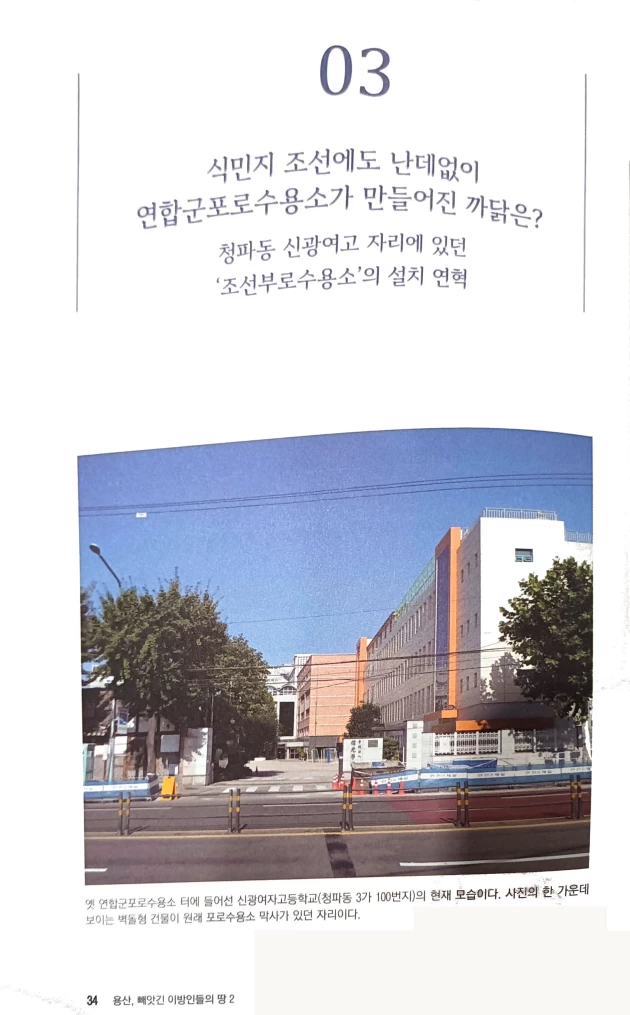
03
Why were allied prisoner-of-war camps suddenly created in colonial Joseon?
History of the establishment of the 'Joseon Buro Camp' located at the site of Shinkwang Girls' High School in Cheongpa-dong
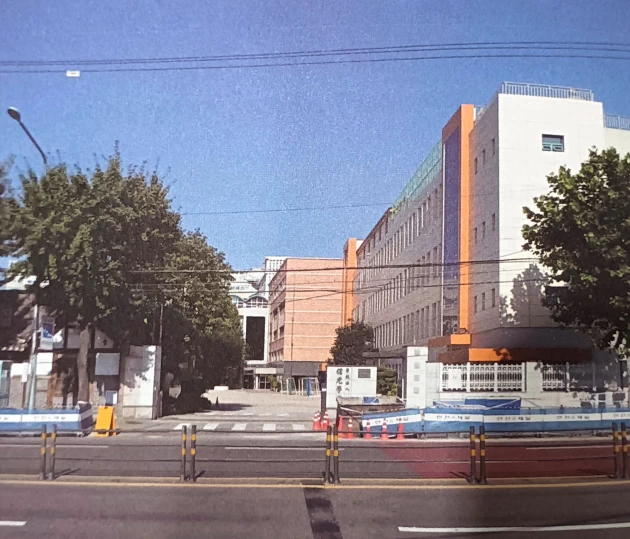
34 Yongsan, the land of stolen strangers 2
Below is a translation of a chapter from Lee Sun-Woo's Yongsan, the Stolen Land of Strangers 2 - Hyochangwon and Manchocheon, the second in a series on the Yongsan area of Seoul, which is south of Seoul railway station and north of the Han River. It was the centre for Japan's military during the occupation and WW2.
The chapter describes the Keijo (Gyeonseong, or present-day Seoul) prisoner of war (buso) camp, where my father was incarcerated for 3.5 years along with British and other Australian troops.
See also: Alexander William Bourne and the Fall of Singapore, my father's account of his time in Keijo Camp.

03

34 Yongsan, the land of stolen strangers 2
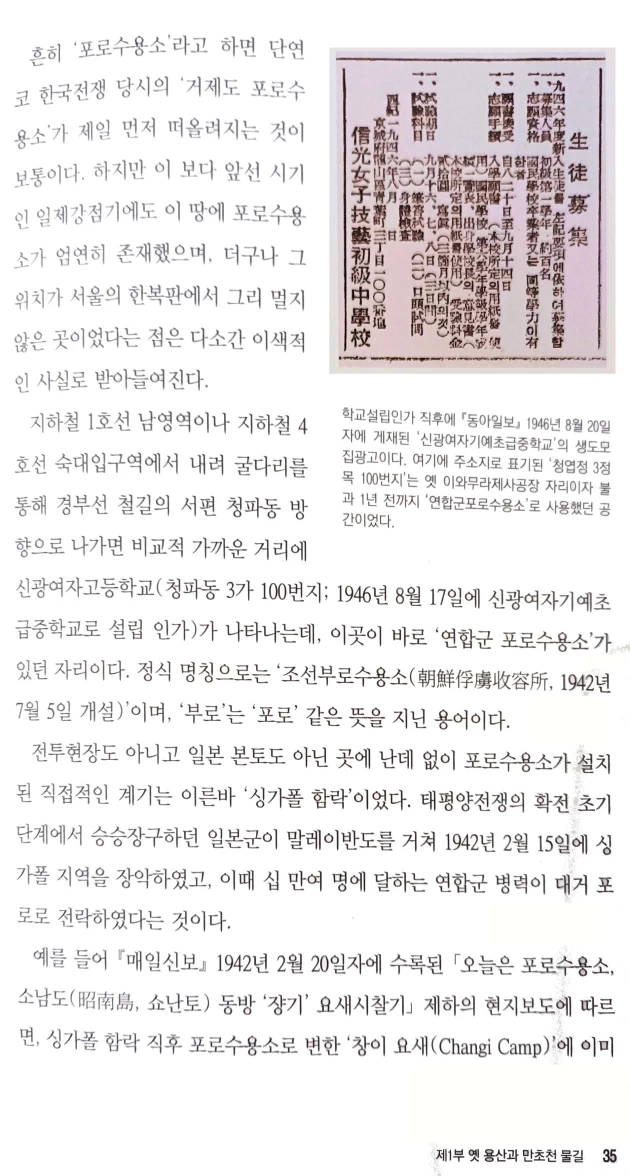
Recruiting for the first year of junior high school, about a hundred people. Qualifications:
Examination fee: 20¥.
You will complete:
(I) Written test
(II) Oral test
(II) Health check
Location: 100, Aoba-cho 3-chome, Yama-ku, Keijo Prefecture
When you think of a 'POW camp', the first thing that comes to mind is the 'Geoje Island POW Camp' during the Korean War. However, a prisoner of war camp existed in Korea even during the earlier Japanese colonial period, and its location was not far from the center of Seoul.
If you get off at Namyeong Station on Subway Line 1 or Sookmyung Women's University Station on Subway Line 4 and go through the tunnel toward Cheongpa-dong on the west side of the Gyeongbu Line, you will find Shinkwang Girls' High School (100 Cheongpa-dong 3-ga; Shinkwang Women's High School on August 17, 1946). Approval for establishment as an elementary middle school) appears, and this is the site of the 'Allied POW camp'. The official name is 'Chosun Buro Camp (opened on July 5, 1942)', and 'buro' is a term that has the same meaning as 'prisoner of war.'
The direct reason for the establishment of a prisoner of war camp out of nowhere in a place that was neither a battle site nor the Japanese mainland was the so-called 'fall of Singapore.' The Japanese army, which was on a roll in the early stages of the expansion of the Pacific War, passed through the Malay Peninsula and took control of Singapore on February 15, 1942, and at this time, a large number of Allied troops, numbering approximately 100,000, were taken prisoner.
For example, according to a local report in the February 20, 1942 issue of 『Maeil Shinbo』 ("Daily News") under the heading "Today is a prisoner of war camp, a report on inspection of the 'Jangi' fortress in the eastern part of Sonam Island ((昭南島, Shonanto)", immediately after the fall of Singapore, prisoners of war already at Changi Camp, which has been turned into a concentration camp.
Part 1 Old Yongsan and Manchocheon Waterway 35
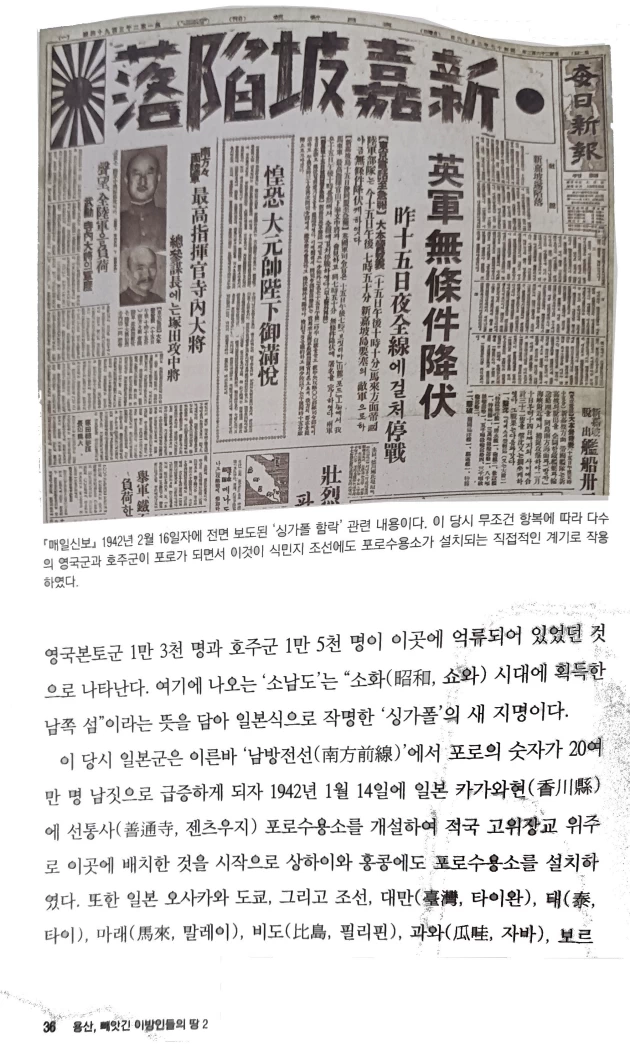
British forces in Singapore's surrender unconditionally At 7:00 pm on the 15th, the "Sankan" met with Lieutenant General Yamashita Tomoyuki, the commander of the Japanese Army, and surrendered unconditionally at 7:50.
Signed by the British Army at 10:00 pm on the 15th.
The battle ceased across the board. Malay Imperial Army Forces in Fortress Singapore.
It appears that 13,000 British mainland soldiers and 15,000 Australian soldiers were detained here. 'Sonamdo' mentioned here is a new place name for 'Singapore', named in Japanese style, meaning "the southern island acquired during the Showa period."
At this time, as the number of prisoners on the so-called 'Southern Front' rapidly increased to over 200,000, the Japanese army captured Seontonji Temple (Zentsu-ji) in Kagawa Prefecture, Japan on January 14, 1942. Starting with opening a prisoner of war camp and placing mainly high-ranking officers of the enemy country there, prisoner of war camps were also set up in Shanghai and Hong Kong. Also, Osaka and Tokyo, Japan, and Joseon, Taiwan, Tai, Malay, Bido (Philippines), Guawa, and Bor.
36 Yongsan, the land of stolen strangers 2
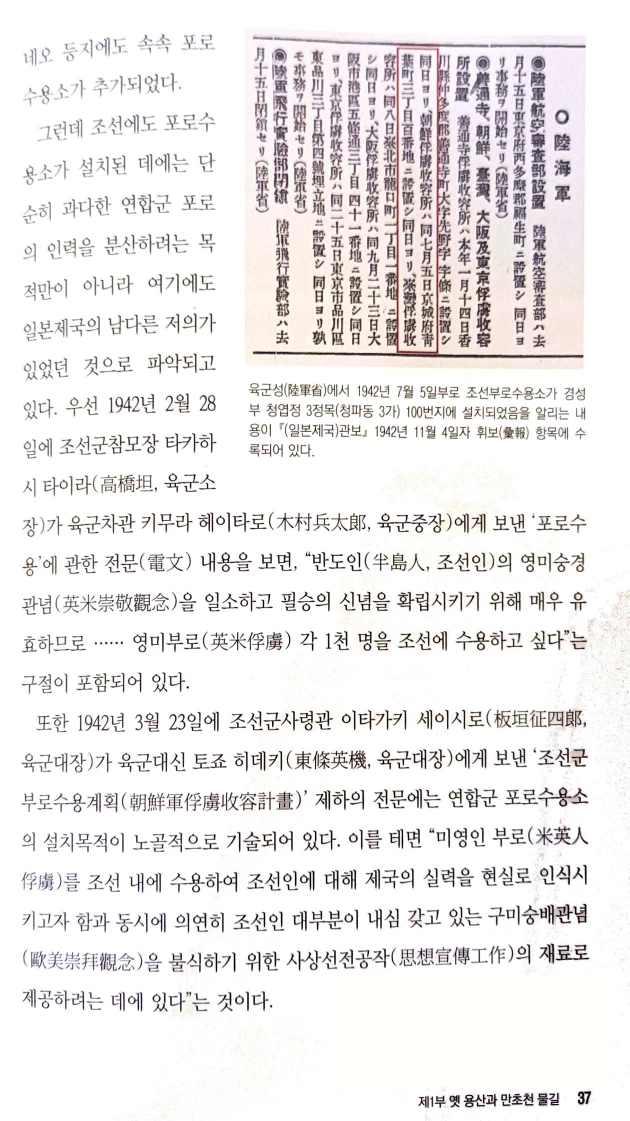
The Army Aviation Inspection Department was established on the 15th of the previous month in Fussa-cho, Nishitama-gun, Tokyo Prefecture. Start of business (Ministry of War) Prisoner of War Camps at Zentsuji Temple, Korea, Taiwan, Osaka and Tokyo were established.
The Army Flight Experiment Department is now closed. Closed auction on the 15th of the month (Ministry of the Army)
POW camps were added one after another in Neo and other places.
However, there were prisoners of war in Joseon as well.
It is understood that the purpose of establishing the camp was not simply to disperse the excessive manpower of Allied prisoners of war, but that the Japanese Empire had a special intention here as well. First of all, the content of the cable regarding the 'use of prisoners' sent by the Chief of Staff of the Korean Army, Taira Takaha (Major General of the Army), to Heitaro Kimura (Lieutenant General of the Army), Vice Minister of the Army, on February 28, 1942. According to the article, "It is very effective in eradicating the peninsula people's (Korean people's) notion of worshiping Anglo-Americans and establishing their belief in sure victory... It includes the phrase, "I want to accept 1,000 people into Joseon."
In addition, on March 23, 1942, the full text titled 'Korean Army Buro Accommodation Plan' sent by Seishiro Itagaki, Commander of the Korean Military Command, to the Minister of the Army, Hideki Tojo. The purpose of establishing Allied prisoner of war camps is explicitly stated. For example, "by accepting the American and British people into Joseon, we wanted to make the Joseon people recognize the power of the empire as a reality, and at the same time, we resolutely dispelled the idea of "worshipping Europe and America that most Joseon people had in their hearts."
"It is intended to provide material for ideological propaganda work in order to do so."
Part 1 Old Yongsan and Manchocheon Waterway 37
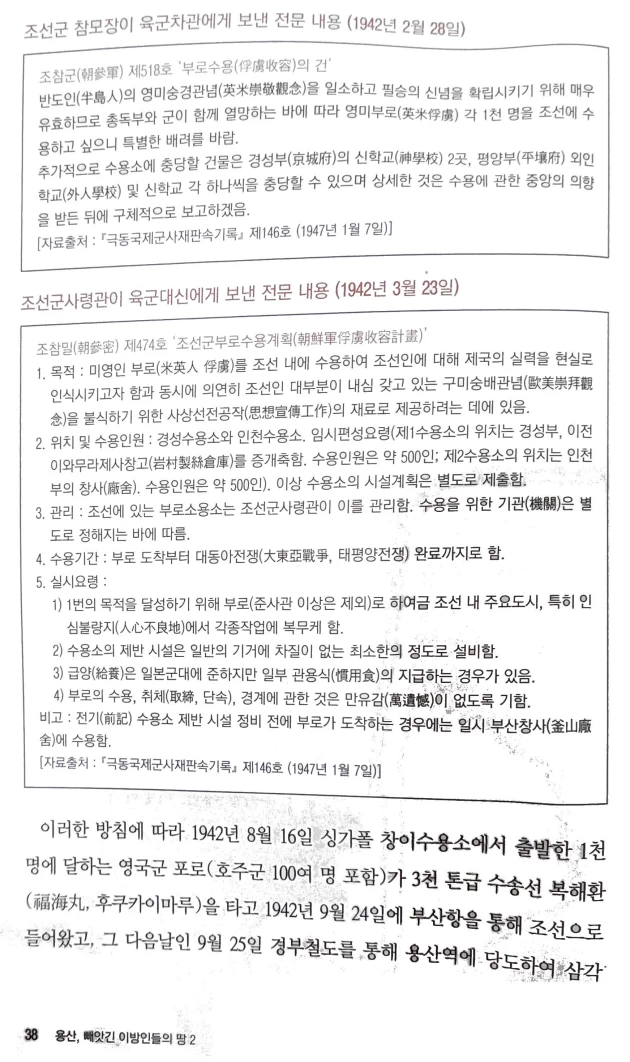
It is very effective in eradicating the idea of reverence for Anglo-Americans among the people of the peninsula and establishing their belief in certain victory, so in accordance with the joint aspirations of the Government-General and the military, 1,000 people each were assigned to British and American departments. Since we want to be accepted into Joseon, we ask for special consideration.
Additionally, the buildings to be provided for the camp can accommodate two seminaries in Gyeongseong-bu and one foreigner's school and seminary in Pyongyang-bu. Details are provided in the central government's intention regarding accommodation. I will report in detail after receiving it.
Note: If a person arrives before the facilities of the previous camp are renovated, he or she will be temporarily detained at Busan Changsa.
According to this policy, on August 16, 1942, about 1,000 British prisoners of war (including about 100 Australian soldiers) departed from Changi Camp in Singapore aboard the 3,000-ton transport ship Bokhae-hwan (Fukukaimaru) on September 1, 1942. It entered Joseon through Busan Port on September 24th, and the next day, September 25th, it arrived at Yongsan Station via Gyeongbu Railway and entered Samgak.
38 Yongsan, the land of stolen strangers 2
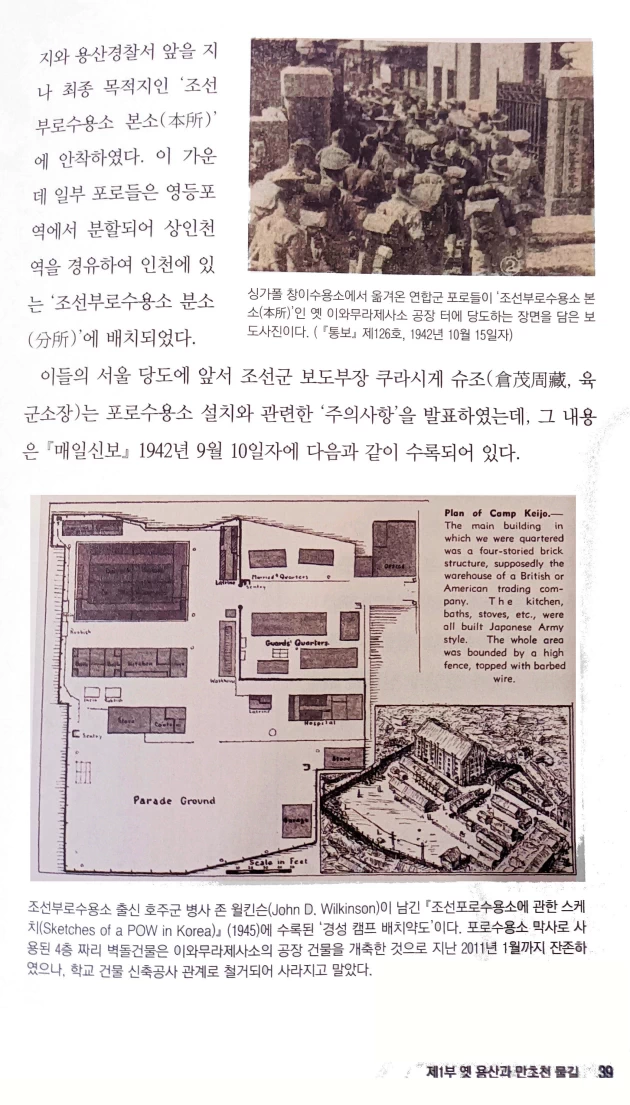
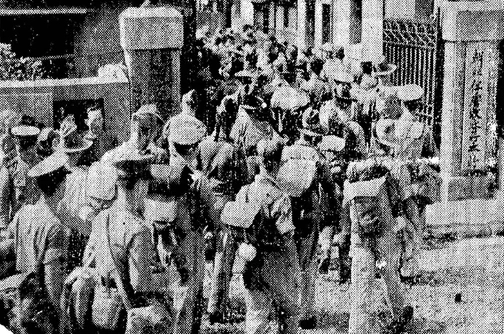
After passing through Ji and Yongsan Police Station, we arrived at our final destination, the 'Chosun Buro Camp Headquarters.' Among these, some prisoners were divided at Yeongdeungpo Station and placed at the 'Joseon Buro Camp Branch' in Incheon via Sangincheon Station.
Prior to their arrival in Seoul, the head of the Joseon Army press department, Shuzo Kurashige (Army Major General), announced 'precautions' regarding the establishment of prisoner of war camps, the contents of which are as follows in the September 10, 1942 edition of the 『Maeil Shinbo』: It is included as follows.
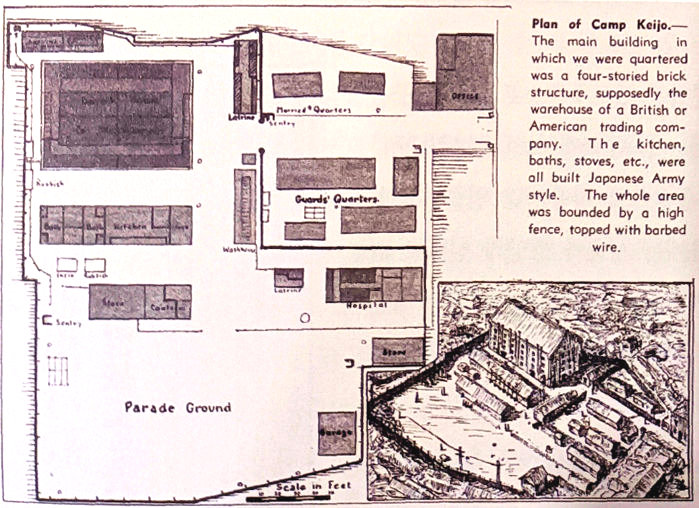
Part 1 Old Yongsan and Manchocheon Waterway 39
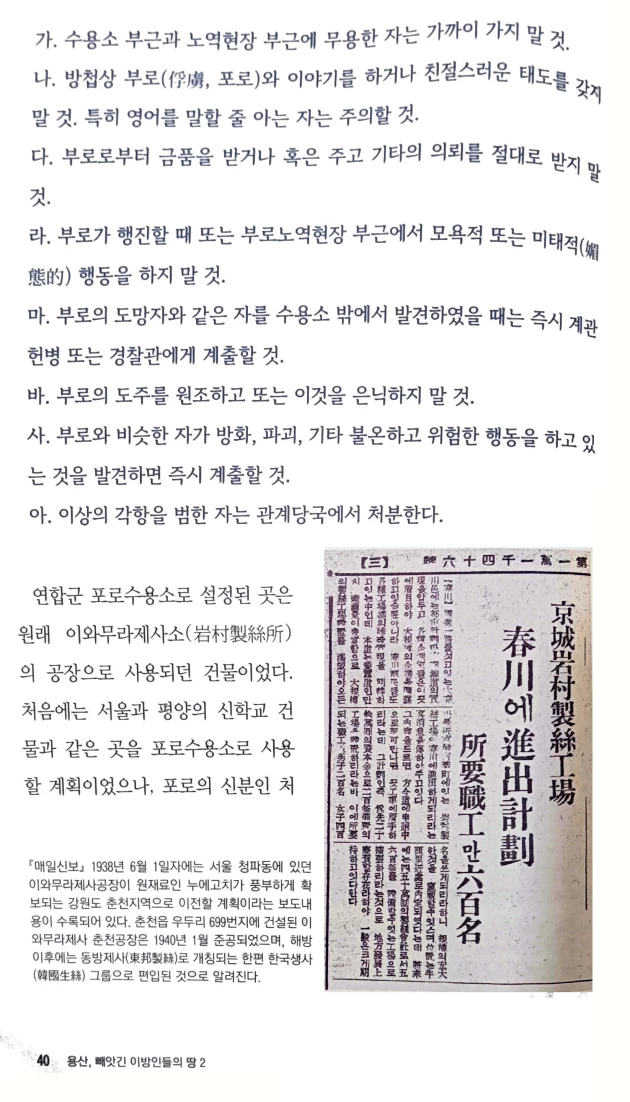
A. Useless people should not go near the camps and labor sites.
B. Do not talk to or be friendly to counterintelligence officers. Those who can speak English should be especially careful.
C. Never receive or give money or other requests from your boss.
D. Do not engage in insulting or indecent behavior when the workers are marching or near the labor site.
E. If a person such as a fugitive from Buro is found outside the camp, report it immediately to the senior military police officer or police officer.
F. Do not aid or conceal theft of wealth.
G. If you discover that someone similar to Buro is committing arson, destruction, or other disturbing and dangerous actions, you should immediately report them.
H. Anyone who violates any of the above provisions will be subject to punishment by the relevant authorities.
The silk factory will move to Chuncheon. It will be a large-scale factory with 200 male and 400 female workers.
It will be near the city railway line in Cheon-eup, which is located in the Shinilro area
Not only are we promoting the development of various industries, but we are also providing water.
It means that 120 people will need 200 pots of capital.
The factory will be near the river and it's expected to be expanded to 11 times its current size.
It will be called the Iwamura Silk Chuncheon Factory.
The place set up as an Allied POW camp was originally a building used as a factory for the Iwamura Silk Mill. Initially, it was planned to use places like seminary buildings in Seoul and Pyongyang as prisoner-of-war camps.
40 Yongsan, the land of stolen strangers 2
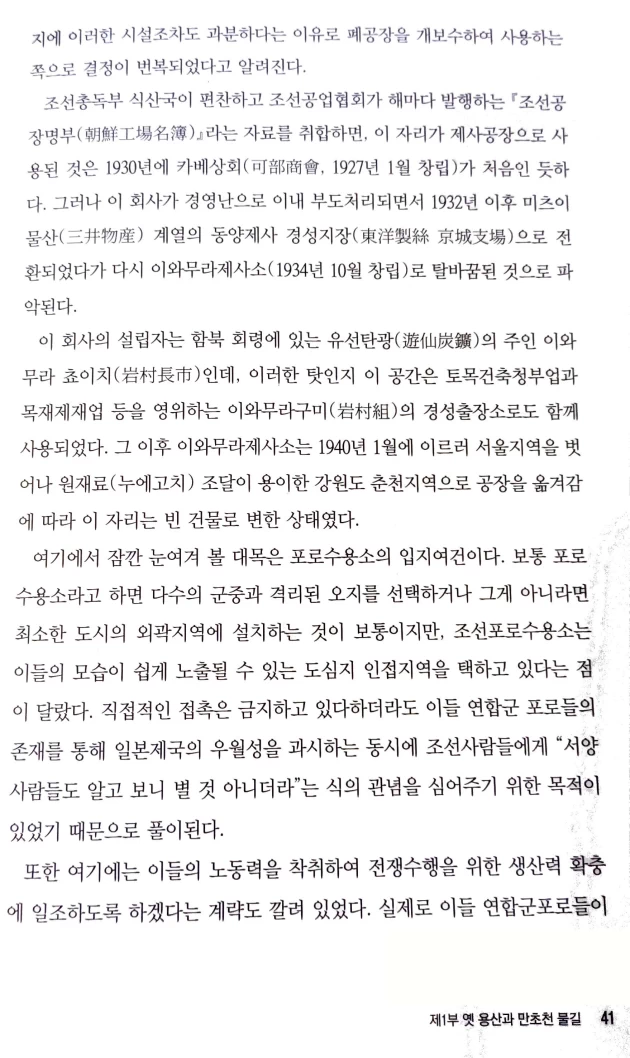
The decision was reversed in favor of renovating and using the abandoned factory on the grounds that these facilities were adequate.
According to the 『Shipbuilder's List』 compiled by the Food Production Bureau of the Japanese Government-General of Korea and published annually by the Joseon Industry Association, this site was first used as a silk mill in 1930 and by Kabe Store in 1927 (founded in January). However, this company soon went bankrupt due to management difficulties, and after 1932, it was converted into Gyeongseong Jizo, an oriental silk woven fabric factory affiliated with Mitsui & Co., Ltd., and then again into Iwamura Silk Mill (founded in October 1934).
The founder of this company is Choichi Iwamura, the owner of Yuseon Coal Mine in Hoeryeong, North Hamgyong Province, and perhaps for this reason, this space is owned by the Iwamura Gumi, which engages in civil engineering and construction contracting and wood lumber business. It was also used as the Gyeongseong branch office. Afterwards, in January 1940, Iwamura Silk Mill moved out of the Seoul area and moved the factory to Chuncheon, Gangwon-do, where it was easy to procure raw materials (silkworm cocoons), and the site became an empty building.
One thing to pay attention to here is the location conditions of the POW camp. Usually, when it comes to prisoner-of-war camps, they are usually set up in remote areas isolated from large crowds, or at least on the outskirts of the city, but the Joseon prisoner-of-war camp is chosen in an area adjacent to the city center where they can be easily exposed. This was different. Even though direct contact was prohibited, the purpose was to show off the superiority of the Japanese Empire through the presence of these Allied prisoners of war, while at the same time instilling in the Korean people the idea that "Westerners are not that special after all."
There was also a plan to exploit their labor to help expand production capacity for the war effort. In fact, these Allied prisoners of war
Part 1 Old Yongsan and Manchocheon Waterway 41
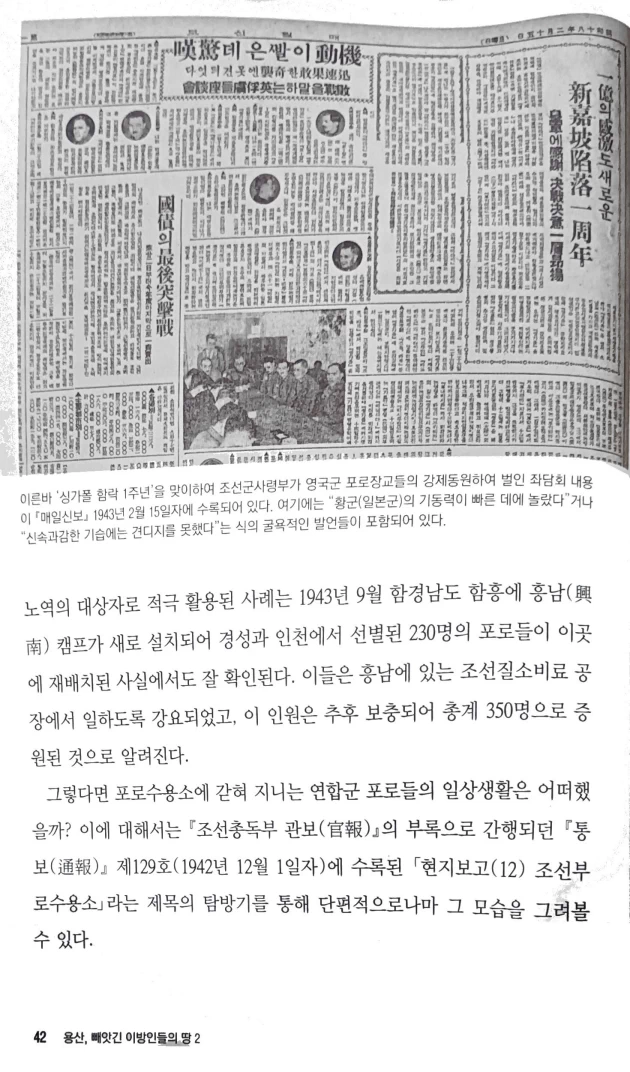
100 million thanks
Gratitude from the Imperial Army, determination to fight even stronger Daring and decisive battle - negotiating and capturing the British
Cases of active use as subjects of labor are clearly confirmed by the fact that the Heungnam Camp was newly established in Hamheung, South Hamgyong Province in September 1943, and 230 prisoners selected from Gyeongseong and Incheon were relocated there. They were forced to work at the Joseon Nitrogen Fertilizer factory in Heungnam, and this number was later replenished and increased to a total of 350 people.
So, what was the daily life of Allied prisoners of war confined in a POW camp? Regarding this, the visit report titled "Field Report (12) Chosun Department Prison Camp" included in 『Tongbo (通報)』 No. 129 (dated December 1, 1942), which was published as an appendix to 『Government-General of Korea Official Gazette』 You can picture it, albeit fragmentarily.
42 Yongsan, the land of stolen strangers 2
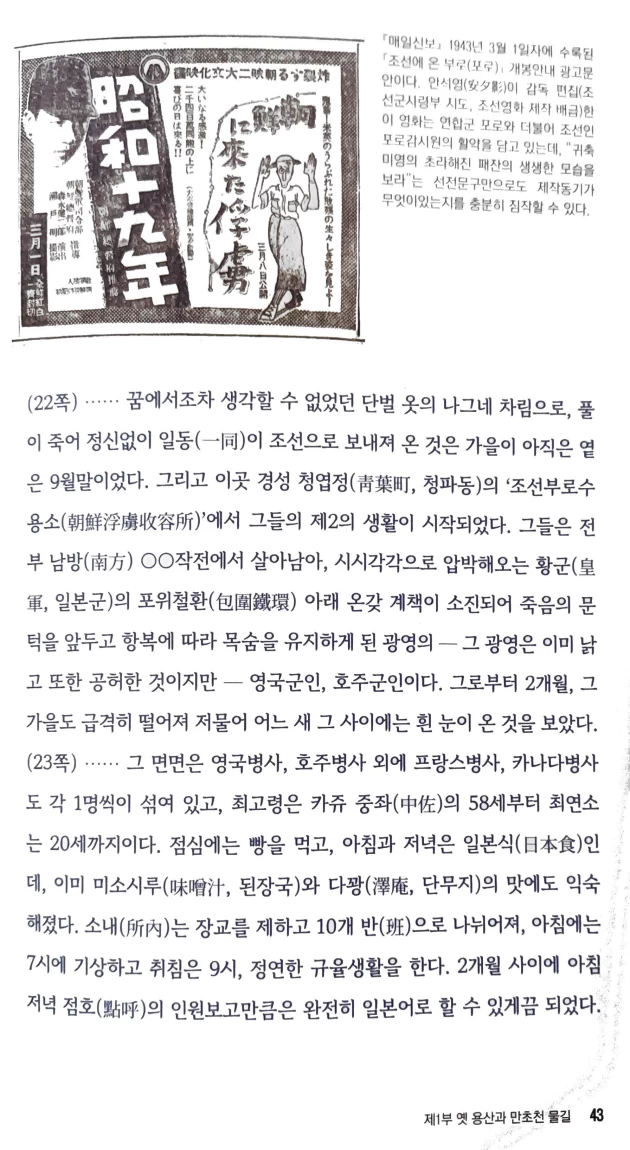
Film, Culture and Literature University Film Festival
Demonic! See the vivid image of the US and Britain in disrepair and defeat!
See foreigners as prisoners of Japan.
Great emotion!
Released on March 8th
Will bring happiness to 24 million Korean compatriots!
The day of joy is coming!!!
Tickets available on March 1st
(Page 22)...... In a single-piece outfit that was unthinkable even in dreams, the group was sent to Joseon in a daze, at the end of September, when autumn was still faint. And here, in the "Joseon Burosu-so (朝鮮浮虜收容所)” of Cheongyeop-jeong (青葉町, Cheongpa-dong) in Gyeongseong, their second life began. They survived the previous Southern Operation, and under the iron ring of the Imperial Army (皇, Japanese Army) that was pressing them in every moment, they were forced to surrender and survive on the verge of death. That glory was already old and empty, but they were British and Australian soldiers. From that point on, after two months, that autumn also came and went rapidly, and in the meantime, I saw white snow.
(Page 23)...... The soldiers were British, Australian, French, and Canadian, and the oldest was Lieutenant Colonel Kaju at 58 years old, and the youngest was 20 years old. We ate bread for lunch and had Japanese food for breakfast and dinner, and we had already become accustomed to the taste of miso soup and da guang (pickled radish). Excluding officers, the unit was divided into 10 classes, and we woke up at 7 in the morning and went to bed at 9, living a disciplined life. In the course of two months, we were able to do the personnel reports for the morning and evening roll calls entirely in Japanese.
Part 1 Old Yongsan and Manchocheon Waterway 43
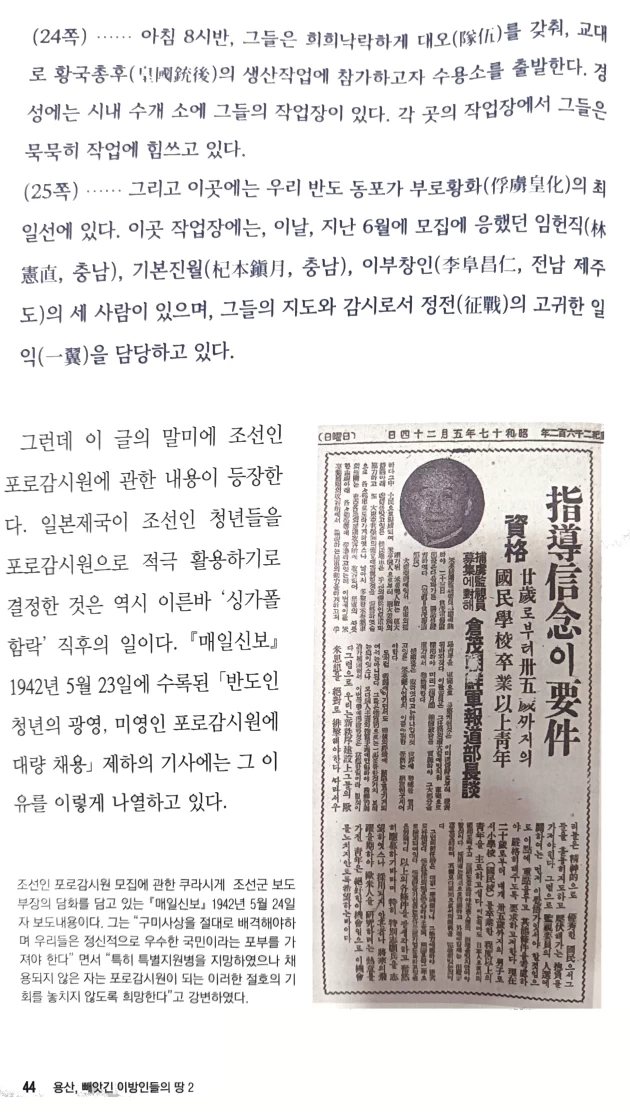
(Page 24)...... At 8:30 in the morning, they joyfully formed a group and took turns leaving the camp to participate in the production work of the Empress Dowager. In Gyeongseong, their workshops are located in several locations throughout the city. In each workplace, they are working silently on their work.
(Page 25)...... And here, our peninsula compatriots are at the forefront of the deterioration of the people. At this workshop, on this day, three people, Lim Heon-jik (林 憲直, South Chungcheong Province), Geon Gi-won Jin-wol (杞本鎭月, South Chungcheong Province), and Lee Buchang-in (李阜昌仁, Jeju-do, Jeollanam-do), who had applied for recruitment last June. As their guidance and supervision, they play a noble role in the war effort.
Bai 42nd month 5th year 70th day Hepeng (Sunday) 260th day of the 2nd month of the 2nd year
20 years old to 35 years old
Graduated from a national school or above
Shigeru Niikura, Director of Military Press Department
As for the Kewon, it is already all wrong. The name of the sea is Mirimjiwon, and it is a large part of Mirimdongya. It is disqualified as a country because it is just a group of people.
So we are in the midst of a fierce competition with the U.S. I was so angry.
We should have the responsibility of guiding and supporting them as Korean citizens mentally. Therefore, the selection of supervisors should be done first, so you should place importance on this and strictly comply with other conditions. Currently, most males in their twenties to 35 years of age are eligible.
We want to focus on young people who have graduated from elementary school (national school) or higher.
However, at the end of this article, information about Korean POW guards appears. It was right after the so-called 'fall of Singapore' that the Japanese Empire decided to actively use young Koreans as prisoner-of-war guards. An article published in 『Maeil Shinbo』 on May 23, 1942, titled "The Glorification of Peninsular Youth, Mass Recruitment of American and British POW Guards" lists the reasons as follows.
44 Yongsan, the land of stolen strangers 2
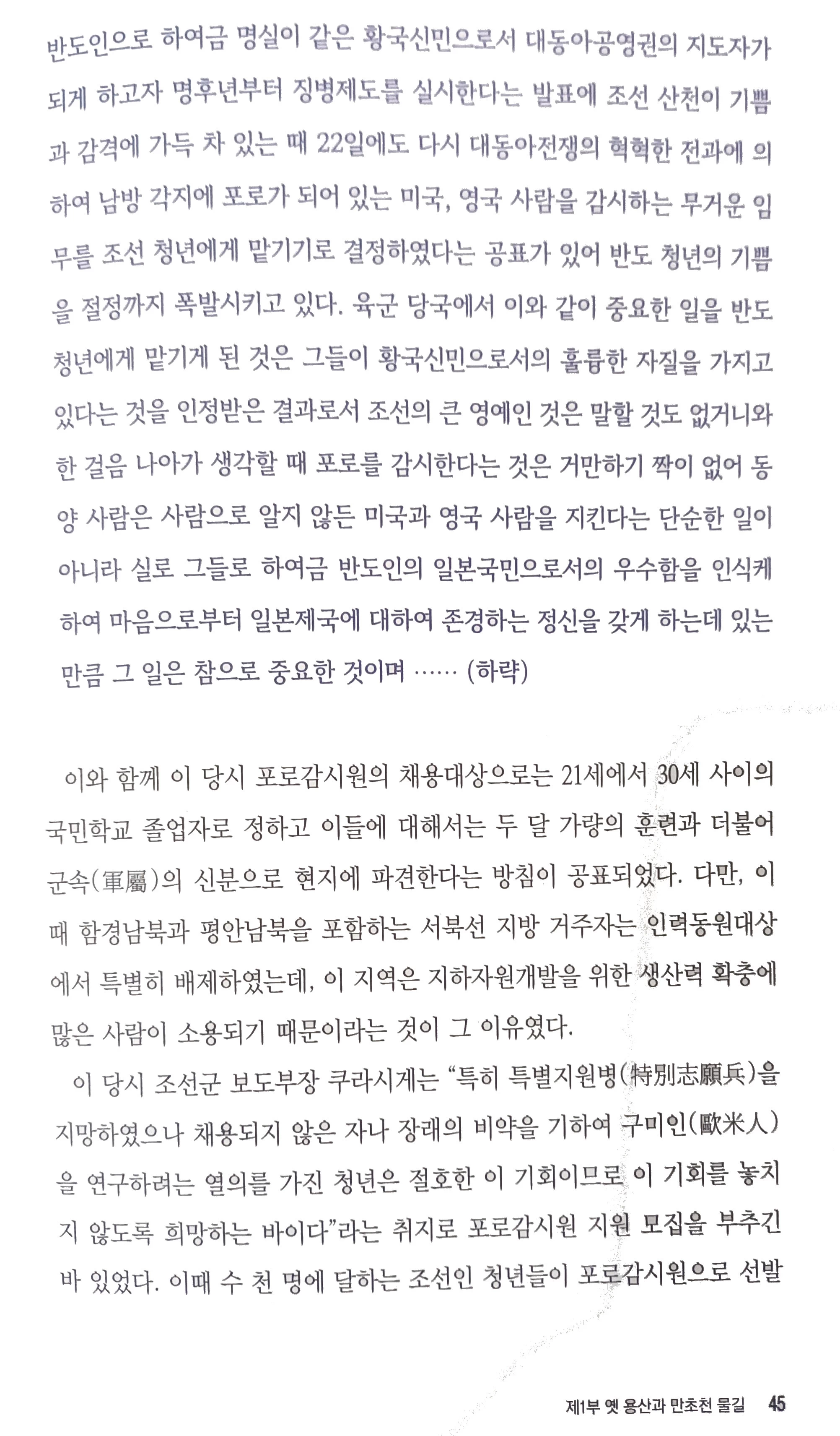
At a time when the mountains and rivers of Joseon were filled with joy and excitement at the announcement that a conscription system would be implemented from the year after next in order to make the people of the peninsula leaders of the Greater East Asia Co-Prosperity Sphere as true imperial subjects, on the 22nd again, there was an announcement that the heavy mission of guarding the American and British prisoners of war in various parts of the south due to their brilliant achievements in the Greater East Asian War would be entrusted to Joseon youth, causing the joy of the youth of the peninsula to explode to the peak.
The fact that the Army authorities entrusted such an important task to the young men of the peninsula was a result of their recognition of their excellent qualities as imperial subjects, and it goes without saying that it was a great honor for Joseon. However, when you think about it a step further, guarding prisoners of war was not simply a matter of guarding Americans and British people, who were arrogant and did not recognize Asians as people. It was truly important to make them recognize the excellence of the peninsula people as Japanese citizens and to have a spirit of respect for the Japanese Empire from the bottom of their hearts. (omitted)
In addition, the target of the recruitment of prisoner guards at that time was to be elementary school graduates between the ages of 21 and 30, and it was announced that they would be sent to the local area as military personnel after receiving about two months of training.
However, residents of the northwestern region, including Hamgyongnam and Buk and Pyeongannam and Buk, were specifically excluded from the target of the manpower mobilization because many people were needed in this region to expand production capacity for underground resource development.
At that time, Kurashige, the head of the Joseon Army's press department, encouraged the recruitment of POW guards with the intention that "especially those who applied for special volunteer service but were not hired, or young people who have a passion for studying Europeans and Americans in order to make a leap forward in the future, this is a great opportunity, so I hope you do not miss this opportunity." At that time, several thousand young Koreans were selected as POW guards.
45 Part 1 Old Yongsan and Manchocheon Waterway
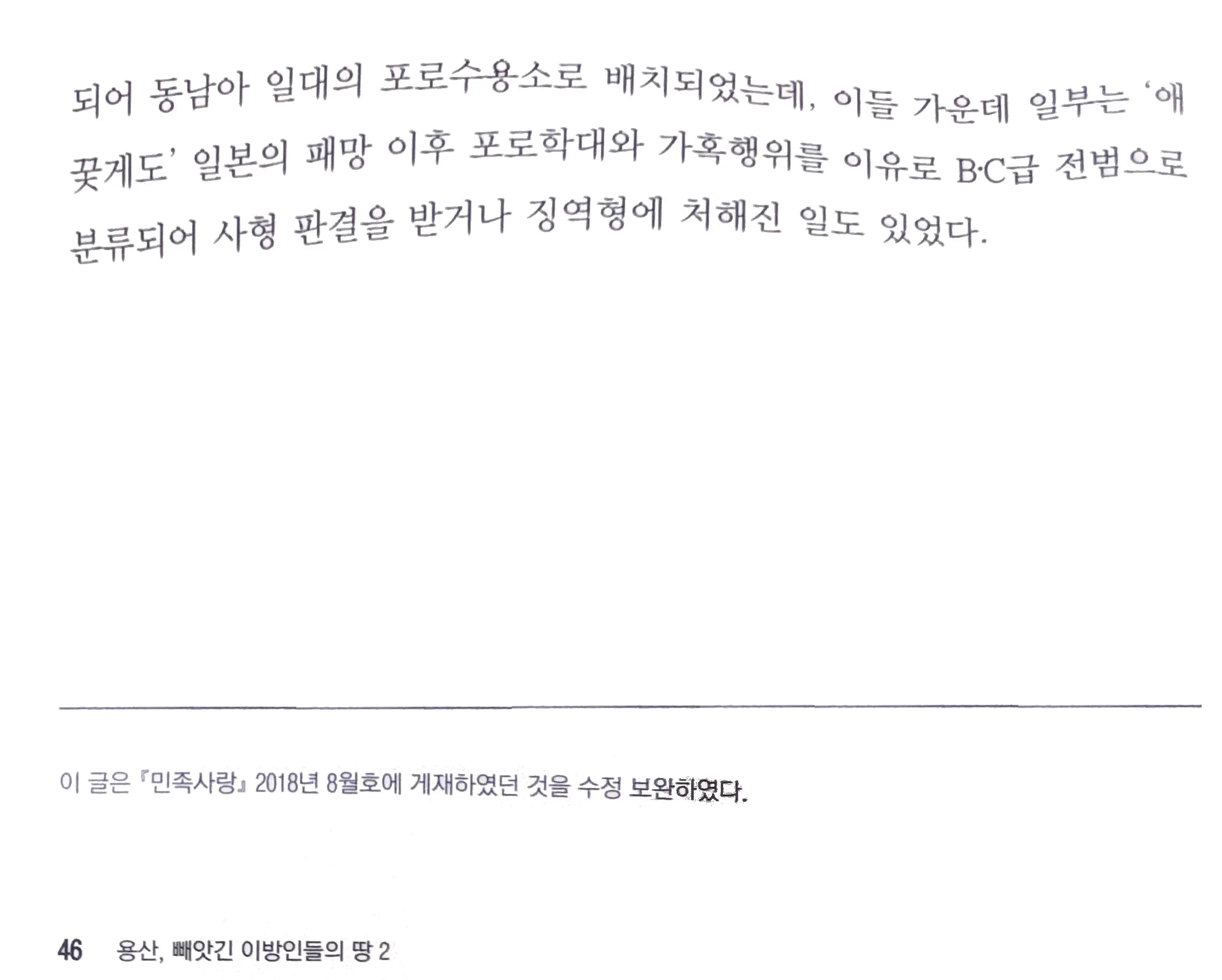
They were assigned to prisoner-of-war camps throughout Southeast Asia, and some of them were classified as BC-class war criminals and sentenced to death or sentenced to prison for their abuse and mistreatment of prisoners after Japan's defeat.
This article has been revised and supplemented from the one that was published in the August 2018 issue of Love for the Nation.
46 Yongsan, the land of stolen strangers 2
용산, 빼앗긴 이방인들의 땅2 (Yongsan, the stolen land of strangers 2 - Hyochangwon and Manchocheon)
Publisher: The Center for Historical Truth and Justice.
Author: Lee Sun-woo
Date of publication: 7 February 2022
Origin: Minyeon Corporation
ISBN: 978-89-93741-37-7
See also: Alexander William Bourne and the Fall of Singapore, my father's account of his time in Keijo Camp.